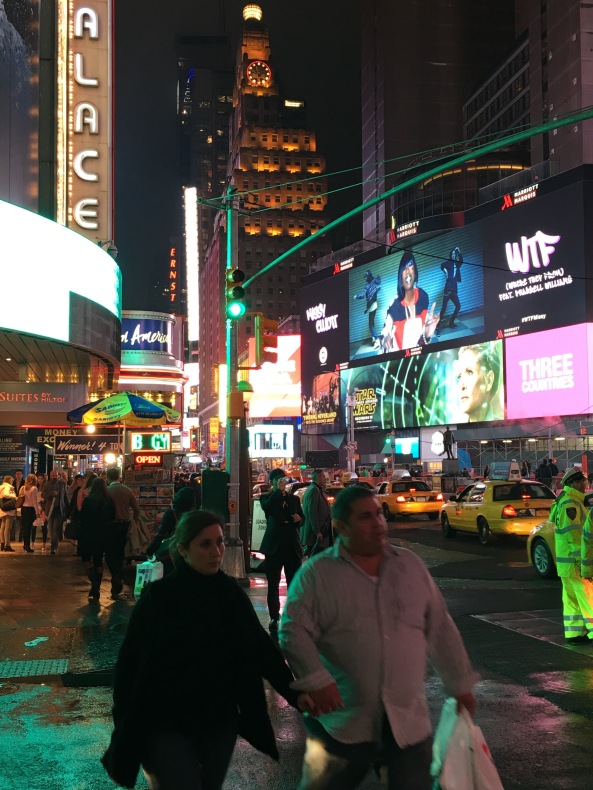New York, New York. It’s a helluva town. It’s a wonderful town. It’s the Big Apple. It’s the city that never sleeps. It’s the town so nice they named it twice. If you can make it there, you can make it anywhere.
New York is a city of neon. It’s a city of brownstones. It’s a city of strangers. It’s a city of frenemies. It’s a city of gentrified slums and genteelly decaying mansions. It’s a city of people who travel the world. It’s a city of people who rarely leave the boroughs they were born in.
And sometimes it’s a city of tourists.
Los Angeles, where Amy and I live, is another city of tourists, a sprawling urban region known largely for being in the background of every other television show ever made. But tourists tend to disappear into the Los Angeles scenery, vanishing somewhere between the beaches and the freeways. You don’t see tourists ogling the buildings in L.A. because, frankly, there aren’t a lot of buildings worth ogling. Instead, you find the tourists on the Venice boardwalk or at nearby Disneyland. Or at Universal Studios Hollywood, an amusement park that used to be an actual tour of a movie studio. Universal Studios Hollywood is Los Angeles pretending to be a replica of Los Angeles.
In downtown Manhattan, tourists are hidden in plain sight, mixing with the locals in a gravitational mass so dense that, like a black hole, it traps the light from the neon signs so that it can never escape into the rest of the universe. New York glows on the interior, not the exterior. New York throbs with internal life. See that photo above? It was taken in downtown Manhattan just before midnight on a Thursday evening, during the five-day stay that Amy and I returned from last week. The city was as alive with light and humanity at that hour as it had been at midday, perhaps even more so. New York isn’t just the city that doesn’t sleep. It’s the city that drinks caffeine when everyone else is taking Tylenol PM. It wakes up when Los Angeles is rolling up its sidewalks. It thrives on darkness — and defies it.
When tourists come to New York, they don’t come to do touristy things, like go to Universal Studios. Well, maybe they come to do a few touristy things, like visit the Statue of Liberty or watch the Rockettes at Radio City Music Hall. But mostly they come to do real things, the sort of things that actual New Yorkers might do…like theater. Theater is something that Amy and I (and quite a few of our friends) are very much into. Theater is what brought us together. And New York is a city of theater, perhaps the greatest theater city on earth with the possible exception of London. We went to Manhattan to see the city, yes, but even more so to see the shows. Much of our time there was spent sitting in theaters, traveling to theaters, having late night coffee after we’d been to theaters. We’d get back to our bed and breakfast after midnight with programs still clutched in our hands. And every show we saw was terrific.
What shows did we see? I thought you’d never ask.
I used my iPhone to keep a visual diary of our theater experience in New York — a visual diary of the posters and marquees, not the interiors of the theaters, where photography is frowned upon, especially during the actual shows. I posted this diary on Facebook during our visit and now I’m going to share it on this blog. No, you don’t have to thank me. I consider it a charitable work.
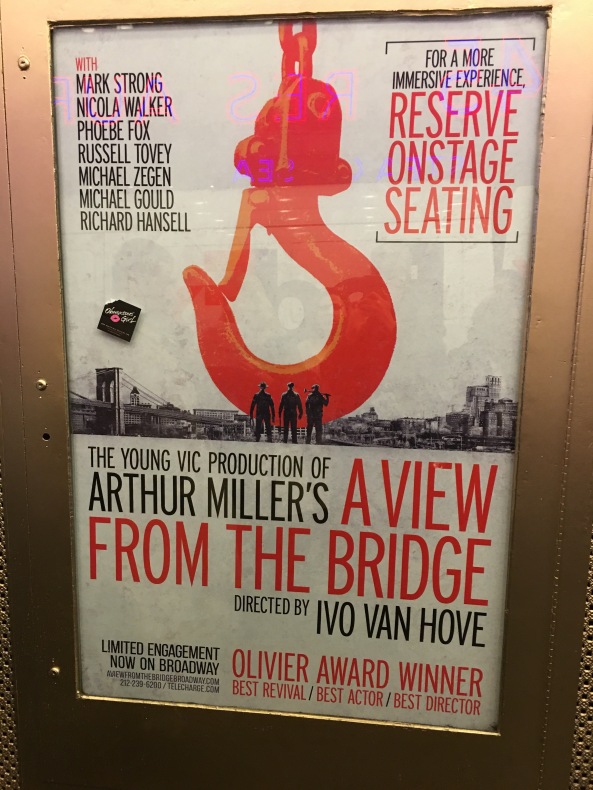
A View from the Bridge at the Lyceum
On Thursday, our first day in New York, we saw Arthur Miller’s A View from the Bridge at the Lyceum. A View from the Bridge is not Miller’s best known play — that’s almost certainly Death of a Salesman — nor is it necessarily his best, but the theater company at London’s the Old Vic has mounted a spare, powerful production that recently transplanted to New York and we had the good fortune to see it from seats located directly on the stage, perhaps ten feet from the actors. It was an unusual staging for the Lyceum, which for the purposes of this production had turned its classical proscenium stage into a thrust stage more like the Mark Taper Forum in Los Angeles, with the audience on three sides of the performers.
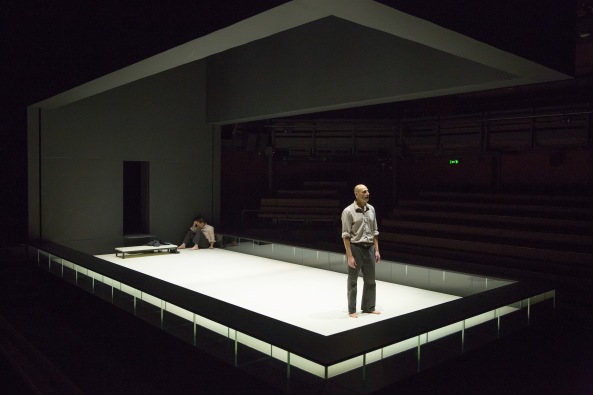
A stage within a stage at the Lyceum. (Not my photo.)
The production is powerful and the cast, headed by Mark Strong, is a standout. Although written in 1956, the play deals with issues that are just as relevant today, if not more so, issues like illegal immigration and acceptance of gays. Director Ivo Van Hove made the somewhat unusual choice of underscoring the entire production with music and ambient sounds pitched barely above the level of audibility — honestly, I’m not sure if the rest of the theater could hear them — that added a nerve-jangling sense of foreboding to the whole show. Well worth seeing.
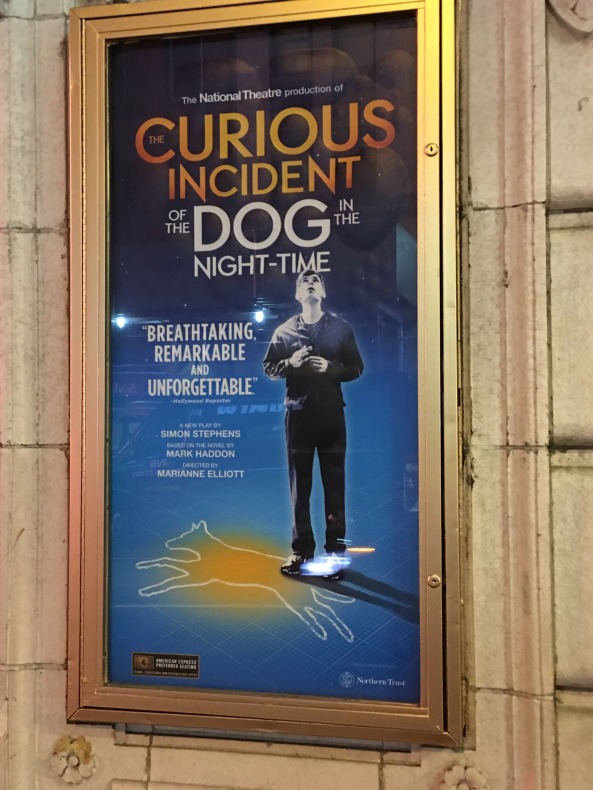
The Curious Incident of the Dog in the Night-Time at the Ethyl Barrymore
Friday night we saw another production recently imported from London, The Curious Incident of the Dog in the Night-Time, Simon Stephens’ adaptation of Mark Haddon’s novel about a high-functioning autistic teenager connecting with his family. It was one of the most stunning pieces of stagecraft I’ve ever seen. While reasonably successful on a dramatic level, The Curious Incident functions best as a sensory experience — it uses the electronic machinery available in modern theaters in an attempt to convey to the audience what it’s like to be autistic. To what degree it succeeds at this, I can’t say; I’m not, as far as I know, autistic.
What the play suggests is that autism is a kind of sensory barrage and that the reaction of the protagonist to emotions and external stimuli is not so much a rejection of the outside world as it’s an attempt to organize and categorize sensory information in a logical, internal grid. This grid is represented literally on the stage as a matrix of lines crossing the floor and the three walls of the stage.
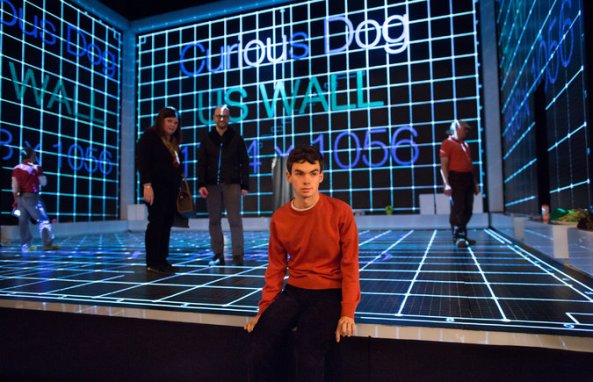
Stage design for The Curious Incident of the Dog in the Night-Time. (Once again, not my photo. Keep your iPhones turned off at all times during shows, folks.)
Inside this matrix, the show’s technicians use projections and flashing electronic lights to suggest how the teenager perceives information. The ultimate effect is not so much moving — though the story is touching and Tyler Lea is excellent in the lead — as it is dazzling. That was enough to make it a riveting evening of theater, though.
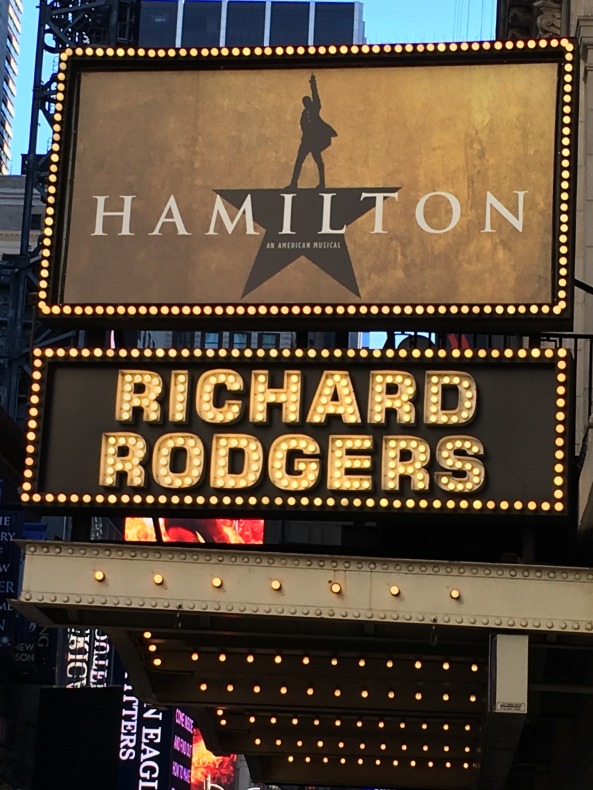
Hamilton at the Richard Rodgers
Saturday was a two-play day, with a matinee and an evening show. The matinee was Hamilton, which is the hottest and most-difficult-to-see musical on Broadway currently but one we weren’t prepared to visit New York without seeing. It was worth the effort we put into getting the seats.
If you haven’t heard of it — and the fact that the cast album is riding high on the Billboard charts at the moment suggests that you might have — Hamilton is a retelling of the late colonial and early independent days of the United States from the viewpoint of the eponymous founding father. What makes it extraordinary is that Broadway wunderkind Lin-Manuel Miranda has framed the story of our early immigrant nation in terms of modern immigrants and minorities, with the Hispanic Miranda himself as Alexander Hamilton and African-American actor Leslie Odom Jr. as his eventual nemesis Aaron Burr. The cast is extraordinary, not just for their performances but for the sheer amount of energy they put into the production. There’s enough electricity onstage in Hamilton to light half of Times Square. The staging, with a pair of turntables nested inside one another to transport the actors in circular arcs, is almost always in motion, turning Hamilton’s life and America’s birth into a spinning kaleidoscope of singing and dancing humanity.

A kaleidoscope of humanity on a pair of turntables
What’s most striking about Hamilton, though, is its score, a pastiche of pop musical styles from the last half century with rap used throughout as a form of hip-hop recitative. Rap has never exactly had a high profile on Broadway (though Miranda used it in his previous show, In the Heights), but the way Miranda marries the hip-hop rhythms to the characters and themes gives the show a freshness that signals his arrival as possibly the most original voice in musical theater since Stephen Sondheim. And if you know how much I like Stephen Sondheim’s music, you know that’s not something I say lightly.
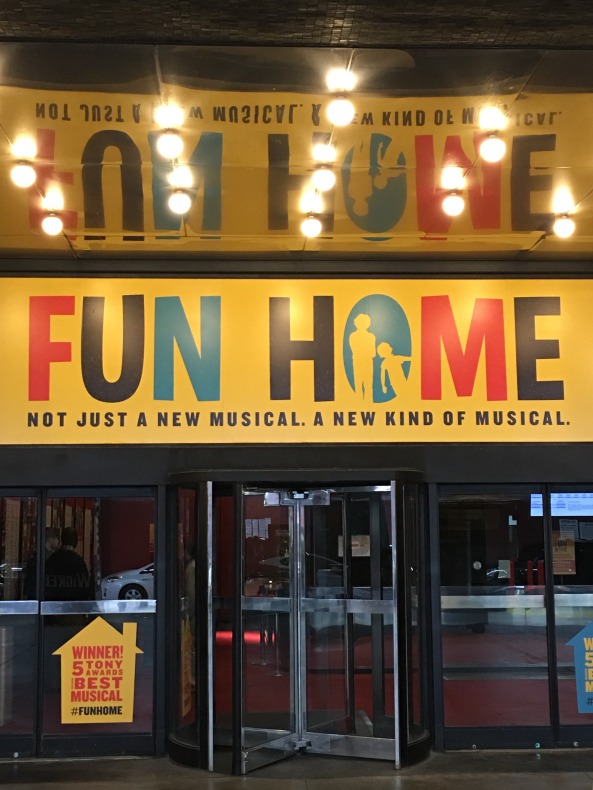
Fun Home at Circle in the Square
You’d think by this point our appetite for theater would be waning. But no. Theater was what we’d flown 2,500 miles to see and theater was damned well what we were going to do. After Hamilton, we went to dinner with friends and then walked to Circle in the Square, where we saw Fun Home, composer Jeanine Tesori and lyricist/playwright Lisa Kron’s adaptation of Alison Bechdel’s autobiographical graphic novel about, among other things, coming of age as a lesbian, learning that her father was a closeted gay male and dealing with her father’s eventual death in a road accident that may or may not have been suicide.
From that description Fun Home might sound like a bit of a chore to get through, but it isn’t. It’s a delight, with a book and score that move deftly from deeply emotional to whimsical and back again. The show is anchored by a standout performance by Michael Cerveris as the father and an excellent turn by Judy Kuhn as Bechdel’s mother, but the actresses who portray Bechdel at three different points in her life, from childhood through college to middle age, are also wonderful, as electric and energetic as anyone in the cast of Hamilton. It was a terrific show.
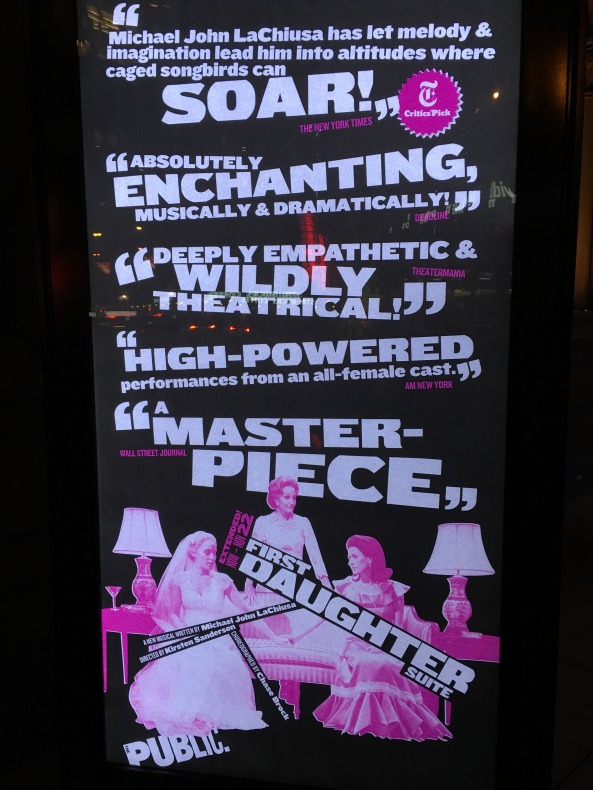
First Daughter Suite at the Public
First Daughter Suite by Michael John LaChiusa, which we saw Sunday evening, was our final show of the trip and our only venture into one of the smaller off-Broadway theaters. Off-Broadway is where LaChiusa’s musicals can typically be found, as well as at regional theaters like Signature in Washington, DC, and The Blank in Los Angeles; to my knowledge only Marie Christine and The Wild Party have made it into theaters officially designated as Broadway houses. This may be because LaChiusa’s shows tend to be both eclectic and eccentric or because he doesn’t write for wide popular tastes. I really don’t know. Amy and I have seen several of his musicals and loved almost all of them. His melodies are soaring and his lyrics both comic and deeply moving.
First Daughter Suite, a companion piece to LaChiusa’s 1993 First Lady Suite, is a set of four musical sketches about the daughters of American presidents: Julie and Tricia Nixon, Susan Ford, Amy Carter, Patti Davis and Pauline Robinson Bush, with large, showy roles for first ladies Pat Nixon, Betty Ford, Rosalynn Carter, Nancy Reagan, Barbara Bush and Laura Bush. Tonally, the show is all over the place, ranging from fantasy and farce in the Amy Carter-Susan Ford scene (which is set in a dream that Carter is having) to something very close to tragedy in the Bush sequence. Each of the four pieces, different as they are from one another, is strong, but the Bush scene turns out to be a surprisingly powerful note to end on, accomplishing something I wouldn’t have thought possible: making me feel sympathy for Barbara Bush.
Monday, in a remarkably smooth plane ride from New York to Los Angeles, we came home — where we could do something we’d barely had the time or the inclination to do in New York: Turn out the lights and go to sleep.
